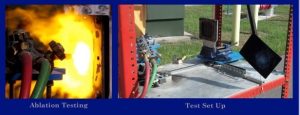Mentor: Jihua Gou
Description: Ceramic matrix composites (CMCs) have become potential candidate materials for combustion chamber shingles, diffusers in aircraft turbines, hot-gas components in stationary gas turbines, heat exchangers and space re-entry vehicle components. CMCs are classified into oxide composites and non-oxide composites. The non-oxide composites can be a combination of non-oxide fiber/non-oxide matrix (e.g. SiC/SiC) or non-oxide fiber/oxide matrix (e.g. C/glass matrix, SiC/Aluminosilicate matrix). The primary advantage of all-oxide composites over the non-oxide composites is their superior resistance to oxidation. To meet environmental and performance standards, it is anticipated that the targeted temperature increase will be achieved through continuous fiber-reinforced CMCs. The oxide fiber-reinforced composites potentially provide excellent oxidation resistance, good thermal stability and, depending on the matrix and the fiber, low creep resistance. However, the weakness in this group of materials lies in high diffusion rates of oxides leading to mechanical and chemical interaction at the fiber-matrix interface and relatively low ultimate strengths. The required thermodynamic stability and oxidation resistance will depend not only on the properties of the fiber, matrix and interface materials, but also on the compatibility of these three. A barrier layer (i.e. an interphase) is necessary between the fiber and the matrix. This module will focus on 3D-woven polymer-derived all-oxide ceramic matrix composites. The advantages of the proposed 3D-woven polymer-derived oxide/oxide CMCs include: (i) Light-weight and high-temperature performance. The oxide/oxide CMC consists of an alumina oxide fiber reinforcement with an alumina oxide or alumina oxide-silicate matrix. The oxide/oxide CMC has a density similar to aluminum and is capable of operating at temperatures up to 1,200°C without a thermal barrier coating (TBC). (ii) Superior fracture toughness. The 3D-woven CMC can overcome the traditional inter-laminar weakness of 2D laminates or monolithic ceramics such as Si3N4 and SiC to result in high fracture toughness. (iii) Net shape manufacturing. Resin transfer molding (RTM) process will be used to accommodate core materials and integrate “mold in” fittings and other hardware into the part structure. Some important internal design features such as cooling holes in a gas turbine blade can be fabricated by integrating 3D-printed plastic inserts during the RTM process. The inserts will be evaporated at a high temperature during the pyrolysis of pre-ceramic polymer to ceramics. (iv) Low cost manufacturing. Unlike traditional melt infiltration process, polymer infiltration and pyrolysis (PIP) process starts from pre-ceramic polymers and then the cured green body is converted into ceramics. All these characteristics can lead to better fuel efficiency, lower noise/emissions, and light-weight composites for high temperature applications.
After training, the REU student working on this module will conduct CMC design by selecting ceramic fibers and matrix. The student will also design the 3D fiber architecture by choosing important design variables such as the z-fiber portion, the z-fiber architecture, the 3D weave type and the 3D weaving process. The student will conduct an experimental study on the polymer infiltration and pyrolysis process to fabricate ceramic matrix and composites. The thermo-mechanical testing (e.g. Oxyacetylene torch ablation test) of these CMCs will be performed in this module. These tasks will prepare the student for further experimental and analytical study of advanced composites for high-temperature applications. Upon the completion of this REU program, the student is expected to present research posters and author/co-author research papers for journals or conferences.

Oxyacetylene torch ablation testing of ceramic matrix composites